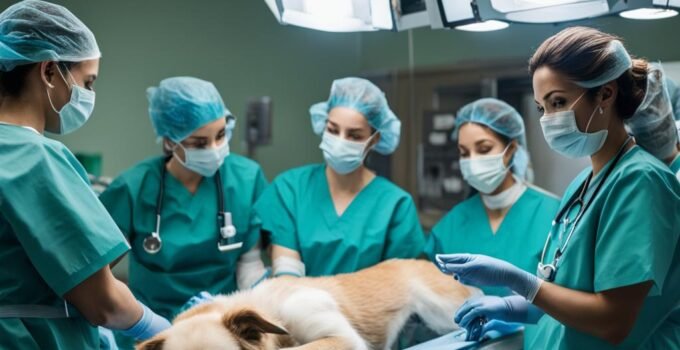If your pet is pregnant and their due date is approaching, it’s important to consider all delivery options. A common delivery procedure is a cesarean section (or C-section), which may be recommended by your pet’s veterinarian before birth or as an emergency birthing option.
Key Takeaways
- Pet insurance can provide coverage for veterinary procedures like emergency C-sections and other unexpected emergencies.
- Before your pet’s due date, consult with your veterinarian to discuss delivery options and potential risks.
- The cost of a dog C-section can vary depending on factors such as the size of your pet, the type of hospital or clinic, and the location.
- Pet insurance policies typically exclude coverage for breeding, pregnancy, whelping, and nursing, unless specific add-ons or policies are available.
- Some pet insurance providers offer coverage for emergency C-sections deemed medically necessary to save the pet’s or puppies’ lives.
Why are cesarean sections performed on pets?
Cesarean sections, commonly known as C-sections, are performed on pets for various reasons, primarily in cases of birthing difficulty or as a life-saving procedure. It is crucial for pet owners to understand the signs of birthing difficulty and consult their veterinarian in order to have a delivery plan in place.
Birthing Difficulty and Risks
Birthing difficulty can arise due to multiple factors. Some signs that indicate potential birthing difficulties include an extended length of pregnancy without labor, the presence of green or black vaginal discharge, strong contractions that do not result in the delivery of a baby within 15 to 30 minutes, exhaustion, dehydration, excessive pain, signs of illness, or the delivery of a stillborn puppy or kitten.
When faced with such challenges, a cesarean section may be recommended to safely deliver the offspring and ensure the well-being of the mother. These procedures are performed under veterinary care to minimize risks and complications.
Importance of a Delivery Plan
At the onset of pregnancy, it is essential for pet owners to establish a delivery plan in consultation with their veterinarian. This plan helps address any potential risks, assess the need for a cesarean section, and ensure proper medical care throughout the birthing process.
A well-defined delivery plan includes regular check-ups, monitoring the progress of the pregnancy, and being prepared for any emergent situations. By having a comprehensive delivery plan in place, pet owners can ensure their pet’s optimal health and the best possible outcome for both the mother and the newborns.
Consulting a veterinarian and having a clear delivery plan can provide pet owners with peace of mind and minimize the risks associated with birthing difficulties.
The average costs of dog C-sections
When it comes to dog C-sections, the cost can vary depending on several factors. These factors include your pet’s size, health status, the type of hospital or clinic where the procedure is performed, and the location of the hospital. Considering these variables, it is difficult to provide an exact cost but, on average, a dog C-section can range between $500 to $4,000.
Factors such as the expertise of the veterinary team, the quality of medical equipment, and the level of care provided can influence the overall cost of the C-section. Additionally, geographical location plays a role, as the cost of veterinary services may vary in different areas. Urban areas and specialized clinics may generally have higher costs compared to rural areas or general veterinary hospitals.
It is important to note that these figures are estimates and may vary depending on individual circumstances and the specific needs of your pet. You should consult with your veterinarian to get a more accurate estimate of the potential costs involved in a dog C-section for your particular situation.
Keep in mind that dog C-section costs are not limited to the actual procedure itself. There may be additional expenses to consider, such as pre-operative consultations and diagnostic tests, post-operative medications, hospitalization fees, and post-surgery follow-up appointments. These additional costs can further impact the overall expenses associated with a dog C-section.
Factors Affecting Dog C-Section Costs
The following factors can influence the cost of a dog C-section:
- Size of the dog: Larger dogs may require more extensive surgical procedures, anesthesia, and aftercare, which can increase costs.
- Health status of the dog: Dogs with pre-existing health conditions may require additional medical interventions and monitoring during the C-section, resulting in higher costs.
- Type of hospital or clinic: Specialized veterinary hospitals or referral centers may have higher fees due to their expertise and advanced medical equipment.
- Geographical location: The cost of veterinary services can vary based on the cost of living and the local market competition in different areas.
It is essential to discuss all potential costs and financial considerations with your veterinarian to ensure you are fully prepared for the expenses associated with a dog C-section. By understanding these factors, you can make informed decisions regarding your pet’s healthcare and budget accordingly.
Pregnancy-related costs not covered by pet insurance
When it comes to pet insurance, it’s essential to understand what costs are covered and what falls under the exclusions. Unfortunately, most pet insurance providers do not cover expenses related to breeding, pregnancy, whelping, nursing, or the treatment of a pet’s babies. These exclusions are important factors to consider when planning for your pet’s healthcare needs.
While pet insurance can provide valuable coverage for unexpected accidents or illnesses, it does not typically extend to the unique circumstances surrounding breeding and pregnancy. This means that expenses related to fertility testing, prenatal care, delivery, and postnatal care are typically not covered by pet insurance policies.
To gain a better understanding of the specific exclusions and limitations of pet insurance policies, it is important to thoroughly explore various insurance options and review sample policies on insurance provider websites. This will help you make an informed decision regarding your pet’s healthcare coverage needs during the breeding and pregnancy journey.
By familiarizing yourself with these exclusions, you can plan ahead and explore alternative financial options for covering the costs associated with breeding, pregnancy, whelping, nursing, and the treatment of your pet’s babies.
Table: Comparison of Pet Insurance Coverage for Pregnancy-Related Costs
| Insurance Provider | Exclusions |
|---|---|
| Provider A | Does not cover breeding, pregnancy, whelping, nursing, or treatment of pet’s babies. |
| Provider B | Excludes expenses related to breeding, pregnancy, whelping, nursing, and the treatment of a pet’s babies. |
| Provider C | Does not provide coverage for the costs arising from or related to breeding, pregnancy, whelping, nursing, or the treatment of a pet’s babies. |
Pregnancy-related costs covered by pet insurance
When it comes to the complications of birthing, pet owners often face unexpected expenses related to emergency C-sections. However, with the right insurance coverage, these costs can be significantly reduced. Fetch pet insurance, for example, offers comprehensive coverage that includes emergency C-sections for your pet.
With Fetch pet insurance, as long as the pregnancy falls after the waiting period of the effective start date of your policy, you can rest assured knowing that any complications during birthing, including the need for an emergency C-section, will be covered. This provides peace of mind and financial protection during what can be a stressful time for both you and your beloved pet.
An insightful case study involving a Yorkshire Terrier demonstrates the value of Fetch pet insurance coverage for emergency C-sections. In this particular case, Fetch reimbursed the pet owner almost $2,448 out of the total vet bill of $3,810 for the emergency C-section procedure. This significant coverage not only alleviates financial burdens but also ensures that your pet receives the necessary medical attention when it matters most.
Yorkshire Terrier Emergency C-Section Coverage
| Total Vet Bill | Reimbursement from Fetch |
|---|---|
| $3,810 | $2,448 |
Costs of Dog C-Sections and Additional Expenses
When it comes to dog C-sections, the costs can vary depending on various factors. One significant factor is whether the procedure is planned or emergent. While planned procedures can be scheduled in advance, emergent procedures are often performed in critical situations to save the mother’s or puppies’ lives.
In addition to the actual surgical costs, there are several additional expenses associated with dog C-sections. Pre-and post-operative care may involve fertility and ovulation testing to determine the ideal timing for the procedure. These tests ensure the highest chances of a successful C-section and a healthy litter.
Moreover, hospitalization is necessary for the mother to recover from the surgery and be monitored for any potential post-operative complications. This typically involves staying at the veterinary clinic or hospital for a few days.
It’s important to note that post-operative complications can arise, requiring further medical attention and potentially increasing the overall costs. These complications could include wound infections, hematomas, or other issues that may require additional surgical interventions.
Furthermore, routine health checks throughout the pregnancy and post-surgery follow-up visits are essential to monitor the mother’s recovery, ensure the well-being of the puppies, and address any potential health concerns.
Considering all these factors, the costs of dog C-sections can add up quickly. Therefore, it’s crucial for pet owners to be financially prepared and understand the potential expenses involved in addition to the surgical procedure.
To give you a better idea of the costs involved, here is a breakdown of the average expenses related to dog C-sections and additional pre- and post-op care:
| Expense | Average Cost |
|---|---|
| Planned Procedure | $800 – $1,200 |
| Emergent Procedure | $1,500 – $3,000 |
| Fertility and Ovulation Testing | $200 – $500 |
| Hospitalization | $500 – $1,000 |
| Post-Operative Complications | $500 – $1,000+ |
| Routine Health Checks | $100 – $200 |
Please note that these costs are approximate and can vary depending on location, the size of the dog, and any unforeseen complications that might arise. It’s always best to consult with your veterinarian to get a more accurate estimate for your specific situation.
Does pet insurance cover C-sections?
When it comes to pet insurance coverage, C-sections can be a complex issue. While most pet insurance companies exclude coverage for pregnancy, breeding, and whelping costs, there are exceptions to consider. Some companies, like AKC and Fetch, offer add-ons or specific policies that cover emergency C-sections deemed medically necessary to save the pet’s or puppies’ lives.
It’s important to read the fine print and understand the coverage restrictions before purchasing a policy. Make sure to review the terms and conditions carefully to determine if C-section coverage is included or available as an optional add-on. This will ensure you have a clear understanding of what is covered and what is not when it comes to C-sections and other breeding-related expenses.
Additionally, keep in mind that coverage for C-sections may come with certain limitations. For example, there may be waiting periods before the coverage becomes effective, or there may be restrictions on the number of C-sections that can be covered per policy term.
To make an informed decision about pet insurance coverage for C-sections, it’s crucial to compare different insurance providers, their policies, and the level of coverage they offer. By doing your research and understanding the fine print, you can ensure that you select the right policy that provides the necessary coverage for your pet’s medical needs.
What’s the Best Pet Insurance for C-sections?
If you plan to breed your dog and C-section coverage is a concern, you’ll want to choose a pet insurance provider that offers limited coverage for Cesareans. Three popular options for pet insurance companies that provide such coverage are Fetch, Figo, and Trupanion.
However, when selecting the best pet insurance for C-sections, there are other factors to consider besides coverage for Cesareans. It’s important to review the specific policy coverage details, customer service reputation, and claim processing timelines offered by each provider.
Let’s take a closer look at these three pet insurance companies:
| Insurance Provider | Limited Coverage for C-Sections | Other Policy Considerations |
|---|---|---|
| Fetch | Yes | Comprehensive coverage, customizable plans, 24/7 vet support, alternative therapy coverage |
| Figo | Yes | Comprehensive coverage, unlimited annual coverage limit, direct vet payment, lost pet recovery |
| Trupanion | Yes | Comprehensive coverage, lifetime coverage, elective surgery coverage, online claims |
Each of these pet insurance providers offers limited coverage for C-sections, ensuring that you have financial protection in the event of an emergency or planned C-section for your pet. However, it’s essential to carefully review their policies to determine which one aligns best with your needs and budget.
Remember to consider factors beyond just C-section coverage, such as additional benefits, policy premiums, and any exclusions that may impact your decision. By thoroughly researching and comparing these insurers, you can make an informed choice and provide the best possible protection for your pet during the birthing process and beyond.
Conclusion
Pet insurance coverage for emergency C-sections can vary significantly among providers. To ensure you make an informed decision, it’s crucial to carefully review the policy details, exclusions, and coverage restrictions before selecting a pet insurance plan. By taking the time to understand the terms and conditions, you can ensure that your pet’s emergency birthing needs are adequately covered.
When planning for breeding, it’s important to consider the potential pregnancy-related costs. While most pet insurance providers do not cover expenses related to breeding, understanding these costs will help you make informed financial preparations.
One option to consider is setting up a savings account dedicated to covering your pet’s potential C-section expenses. This allows you to have a financial safety net in case of an emergency. Additionally, some pet insurance providers offer pet-specific credit cards that can help to manage unexpected veterinary expenses.
Remember, careful coverage considerations, thorough breeding planning, and diligent financial preparation can help you navigate the potential costs of emergency C-sections and ensure the well-being of your beloved pet.



